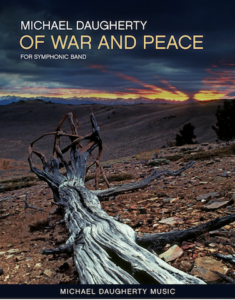Of War and Peace
for symphonic band (2017)
Publisher: Michael Daugherty Music
Duration: 13:30 minutes
World Premiere: March 9, 2017 / Texas A&M University Commerce Wind Ensemble / conducted by Phillip Clements / Texas A&M University-Commerce, Finney Concert Hall, Commerce, Texas

Program Note:
1. War
2. Peace
Of War and Peace (2017) for Symphonic Band was commissioned by the Zeta Kappa chapter of Kappa Kappa Psi and the Epsilon Beta chapter of Tau Beta Sigma from Texas A&M University-Commerce along with a consortium of Kappa Kappa Psi and Tau Beta Sigma chapters from across Texas, Oklahoma and Arkansas. The work is scored for piccolo, 4 flutes, alto flute, 2 oboes, English horn, Eb clarinet, 3 clarinets (minimum 2 players per part), bass clarinet, 2 bassoons, contrabassoon and contrabass clarinet or bass saxophone, soprano saxophone, alto saxophone, tenor saxophone, baritone saxophone, 4 trumpets in C or Bb, 4 horns, 4 trombones, 2 euphoniums, 2 tubas, timpani, 4 percussion, piano/celesta, optional harp and contrabass.
Of War and Peace (2017) is my sonic response to the never ending tragedy of war and the hope for peace. The composition is in two movements performed without pause. The music I have composed for the first movement entitled “War” is turbulent, relentless and seductive. Swirling woodwind cluster chords charge into a fast moving requiem performed by brass, saxophones, chimes, timpani and drums. Punctuated by an unyielding woodblock, a provocative polytonal parade morphs into a brutal but seductive march: there are still those who are foolishly attracted to the allure of war and in denial of the suffering it brings to those “in harm’s way.” The music I have composed for the second movement entitled “Peace” is calm, longing, and reflective. Bassoons, clarinets and oboes sing a haunting melody accompanied by “change ringing” crotales, glockenspiel, marimba and celeste.
After re-orchestrations of the opening material, a stormy dramatic middle section featuring the horns and euphoniums interrupts the proceedings. This intrusion suggests the dark psychological residue often suffered by the victims of war. An “heroic” coda is followed by a “hopeful” (or is it naïve?) musical epilogue, which proposes a time when we can “imagine all the people living in peace…and the world will be as one.”
–Michael Daugherty
